05 May 2018 ~ 9 min read
A Simple Guide to Understanding ES6 Generators
If you’ve been a JavaScript developer for the last two to five years you will have definitely come across posts talking about Generators and Iterators. While Generators and Iterators are inherently associated, Generators seem a bit more intimidating than the other.
 Generator Turbine
Generator Turbine
Iterators are an implementation of Iterable objects such as maps, arrays and strings which enables us to iterate over them using next(). They have a wide variety of use cases across Generators, Observables and Spread operators.
I recommend the following link for those of you who are new to iterators, Guide to Iterators.
To check if your object conforms to the iterable protocol, verify using the built-in Symbol.iterator:
new Map([[1, 2]])[Symbol.iterator]() // MapIterator {1 => 2}
“hi”[Symbol.iterator]() // StringIterator {}
[‘1’][Symbol.iterator]()** // Array Iterator {}
new Set(\[1, 2])[Symbol.iterator]()// SetIterator {1, 2}
Generators introduced as part of ES6 have not undergone any changes for the further JavaScript releases and they are here to stay longer. I mean really long! So there is not running away from it. Although ES7 and ES8 have some new updates, they do not have the same magnitude of change that ES6 had from ES5, which took JavaScript to the next level, so to speak.
By the end of this post, I am positive that you will have a solid understanding of how function Generators work. If you are a pro, please help me improve the content by adding your comments in the responses. Just in case if you have difficulty following the code, I have also added explanation for most of the code to help you understand better.
Introduction
Functions in JavaScript, as we all know, “run until return/end”. Generator Functions on the other hand, “run until yield/return/end”. Unlike the normal functions Generator Functions once called, returns the Generator Object, which holds the entire Generator Iterable that can be iterated using next() method or for…of loop.
Every next() call on the generator executes every line of code until the next yield it encounters and suspends its execution temporarily.
Syntactically they are identified with a star. Eg: function *X or function* X.
Once created, calling the generator function returns the Generator Object. This generator object needs to be assigned to a variable to keep track of the subsequent next() methods called on itself. If the generator is not assigned to a variable then it will always yield only till first yield expression on every next().
The generator functions are normally built using yield expressions. Each yield inside the generator function is a stopping point before the next execution cycle starts. Each execution cycle is triggered by means of next() method on the generator.
On each next() call, the yield expression returns its value in the form of an object containing the following parameters.
{ value: 10, done: false } // assuming that 10 is the value of yield`
- Value — is everything that is written on the right side of the yield keyword, it can be a function call, object or practically anything. For empty yields this value is undefined.
- Done — indicates the status of the generator, whether it can be executed further or not. When done returns true, it means that the function has finished its run.
(If you feel that its a bit over your head, you will get more clarity once you see the example below…)
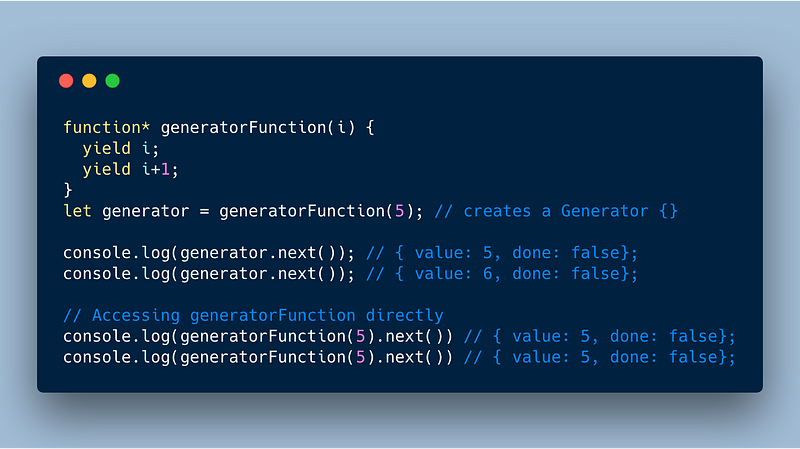 Basic generator function
Basic generator function
Note: In the above example the generator function accessed directly without a wrapper always executes only until the first yield. Hence, by definition you need to assign the Generator to a variable to properly iterate over it.
Lifecycle of a Generator Function
Before we proceed further, let’s take a quick look at the block diagram of the Generator Function’s life-cycle:
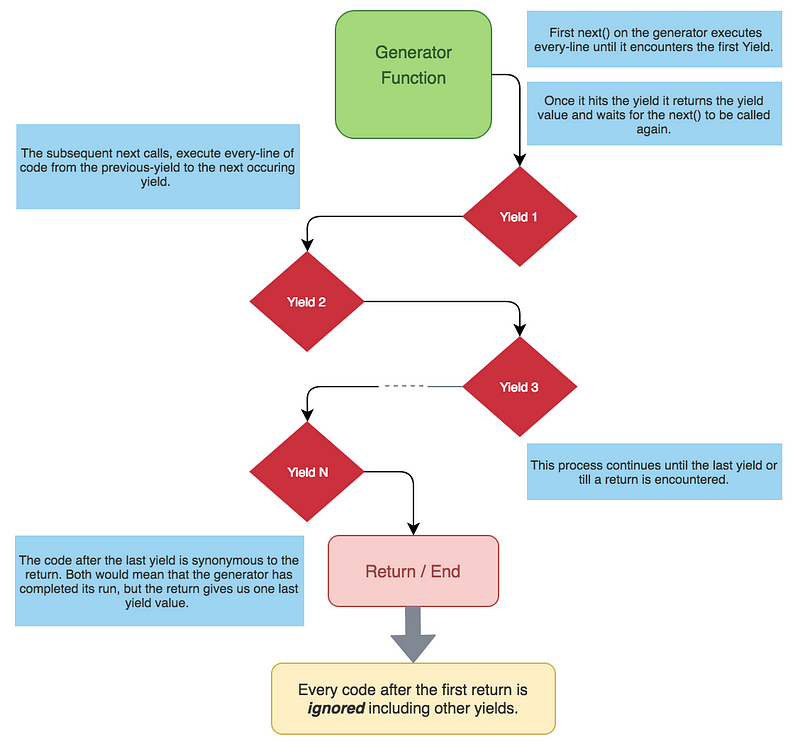 Life-cycle of a Generator Function
Life-cycle of a Generator Function
Each time a yield is encountered the generator function returns an object containing the value of the encountered yield and the done status. Similarly, when a return is encountered, we get the return value and also done status as true. Whenever, done status is returned as true, is essentially means that the generator function has completed its run, and no further yield is possible.
Everything after the first return is ignored, including other yield expressions.
Read further to understand the block diagram better.
Assigning Yield to a Variable
In the previous code sample we saw an introduction to creating a basic generator with a yield. And got the expected output. Now, let’s assume that we assign the entire yield expression to a variable in the code below.
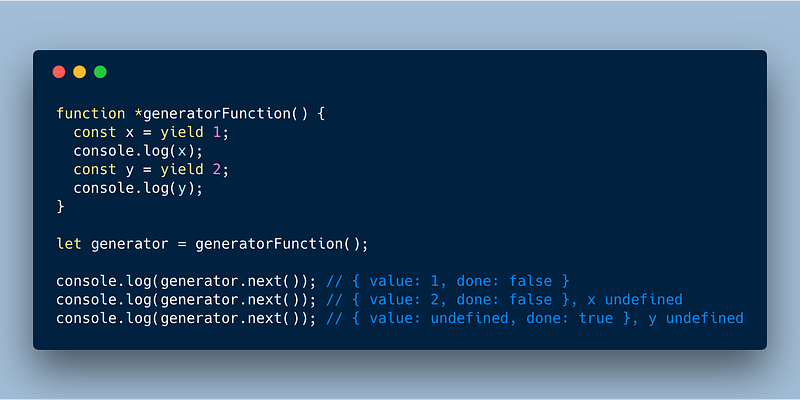 Assigning yield to a variable
Assigning yield to a variable
What is the result of the entire yield expression passed to the variable ? Nothing or Undefined …
Why ? Starting from second next(), the previous yield is replaced with arguments passed in the next function. Since, we do not pass anything here in the next method, its assumed that the entire ‘previous-yield expression’ as undefined.
With this in mind, let’s jump to the next section to understand more about passing argument to the next() method.
Passing Arguments to the next() Method
With reference to the block diagram above, let’s talk about passing arguments into the next function. This is one of the most trickiest part of the whole generator implementation.
Let’s consider the following piece of code, where the yield is assigned to a variable, but this time we pass a value in the next() method.
Let’s look at the code below in the console. And the explanation right after that.
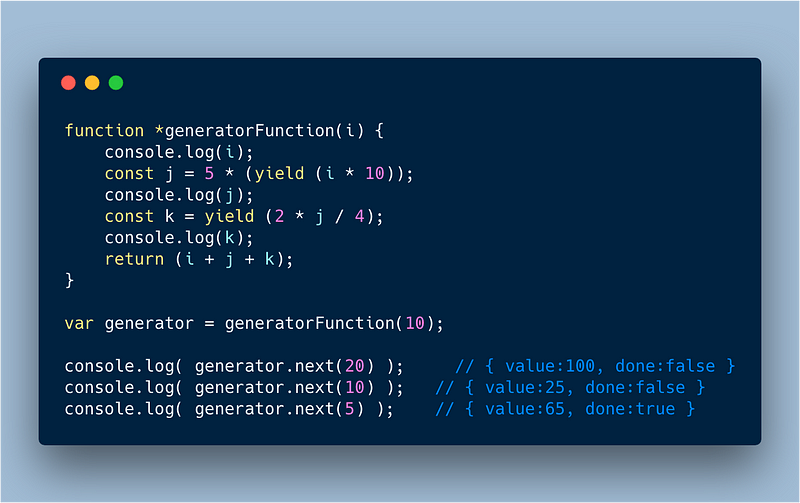 Passing arguments to the next()
Passing arguments to the next()
Explanation:
- When we call the first next(20), every line of code till the first yield is printed. As we do not have any previous yield expression this value 20 is discarded. In the output we get yield value as i10, which is 100 here. Also the state of the execution stops with first yield and the const j is not yet set.
- The second next(10) call, replaces the entire first yield expression with 10, imagine yield (i 10) = 10, which goes on to set the value of const j to 50 before returning the second yield’s value. The yield value here is 2 50 / 4 = 25.
- Third next(5), replaces the entire second yield with 5, bringing the value of k to 5. And further continues to execute return statement and return (x + y + z) => (10 + 50 + 5) = 65 as the final yield value along with done true.
This might be bit overwhelming for the first time readers, but take a good 5 minutes to read it over and over again to understand completely.
Passing Yield as an Argument of a Function
There are n-number of use-cases surrounding yield regarding how it can be used inside a function generator. Let’s look at the code below for one such interesting usage of yield, along with the explanation.
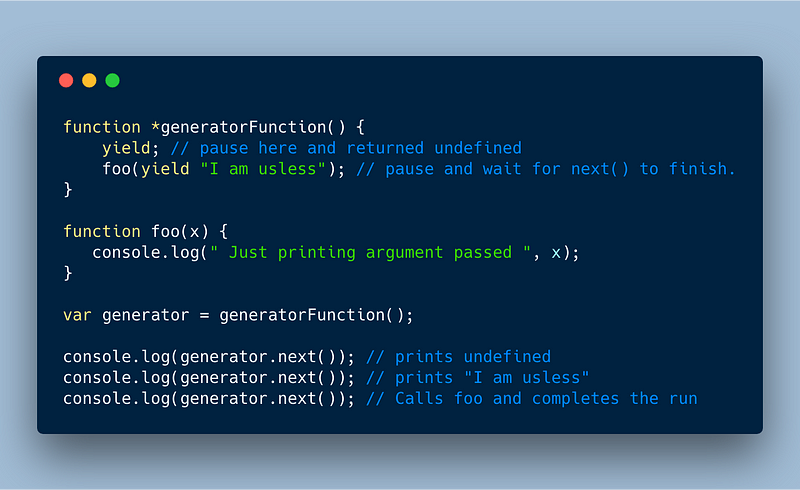 Yield as an argument of a function
Yield as an argument of a function
Explanation
- The first next() yields undefined value because yield expression has no value.
- The second next() yields “I am usless”, the value which was passed. And prepares argument for function call.
- The third next(), calls the function with an undefined argument. As mentioned above, the next() method called without any arguments essentially means that the entire previous yield expression is undefined. Hence, this prints undefined and finishes the run.
Yield with a Function Call
Apart from returning values yield can also call functions and return the value or print the same. Let’s look at the code below and understand better.
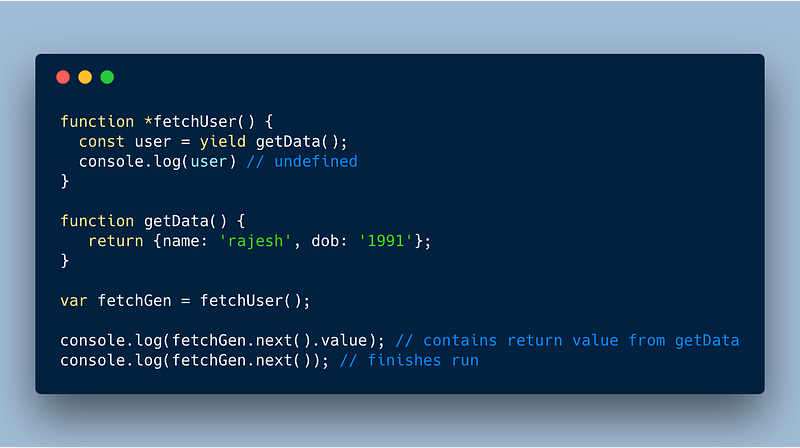 Yield calling a function
Yield calling a function
The code above returns the function’s return obj as the yield value. And ends the run by setting undefined to the const user.
Yield with Promises
Yield with promises follows the same approach as the function call above, instead of returning a value from the function, it returns a promise which can be evaluated further for success or failure. Let’s look at the code below to understand how it works.
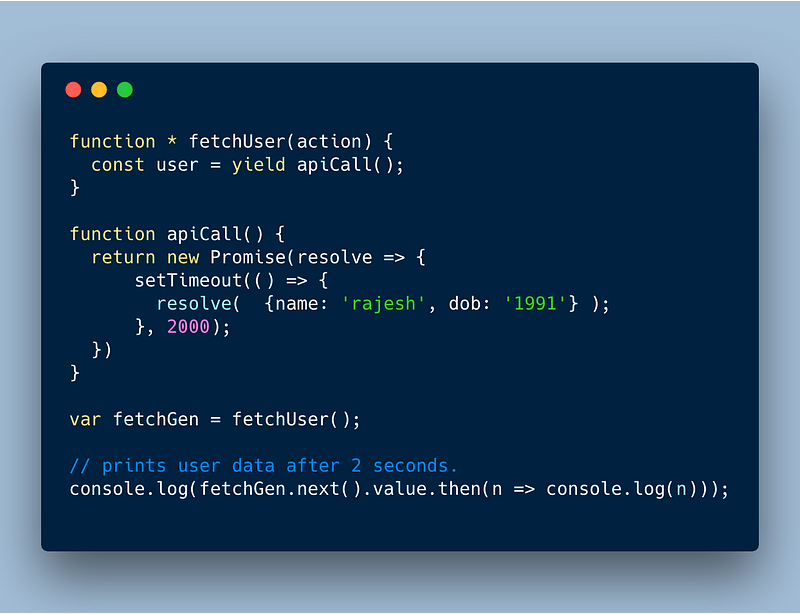 Yield with promises
Yield with promises
The apiCall returns the promises as the yield value, when resolved after 2 seconds prints the value we need.
Yield
So far we have been looking at the use cases for yield expression, now we are going to look at another expression called yield. Yield when used inside a generator function delegates another generator function. Simply put, it synchronously completes the generator function in its expression before moving on to the next line.
Let’s look at the code and the explanation below to understand better. This code is from the MDN web docs.
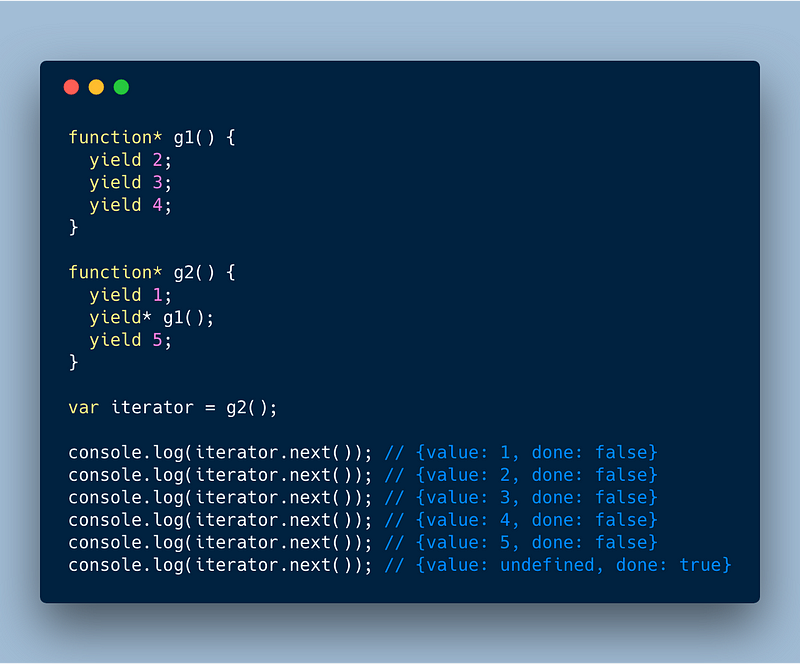 Basic yield
Basic yield
Explanation
- The first next() call yields a value of 1.
- The second next() call, however, is a yield expression, which inherently means that we are going to complete another generator function specified in the yield expression before continuing the current generator function.
- In your mind, you can assume that the code above is replaced like the one below
function* g2() {
yield 1;
yield 2;
yield 3;
yield 4;
yield 5;
}
This will go on to finish the generator run. However, there is one distinct ability of the yield which you should keep in mind while using return, in the next section.
Yield with Return
Yield with a return behaves a bit differently than the normal yield. When yield is used with a return statement it evaluates to that value, meaning the entire yield function() becomes equal to the value returned from the associated generator function.
Let’s look at the code and the explanation below to understand it better.
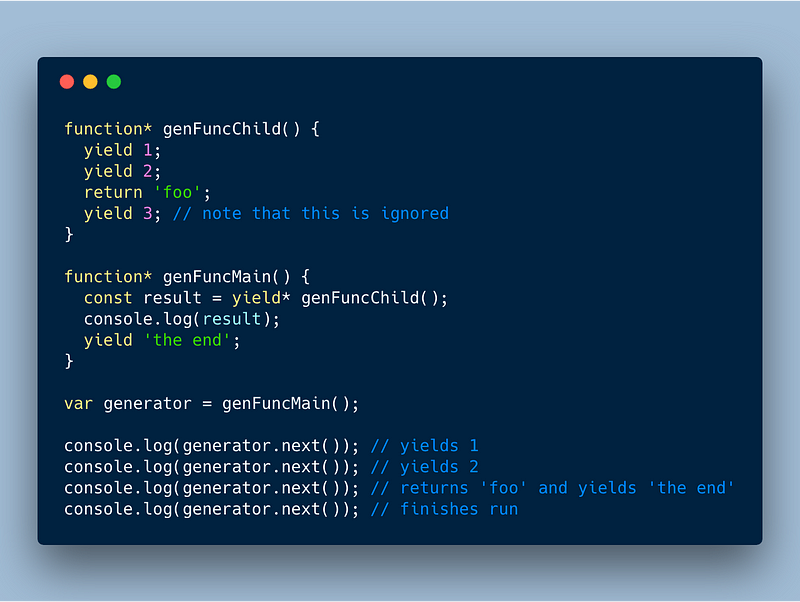 Yield with return
Yield with return
Explanation
- In the first next() we go straight to the yield 1 and return its value.
- The second next() yields 2.
- The third next(), returns ‘foo’ and goes on to yield the ‘the end’, assigning ‘foo’ to the const result on the way.
- The last next() finishes the run.
Yield with a Built-in Iterable Object
There is one more interesting yield property worth-mentioning, similar to the return value, yield can also iterate over iterable objects like Array, String and Map.
Let’s look at how it works in real-time.
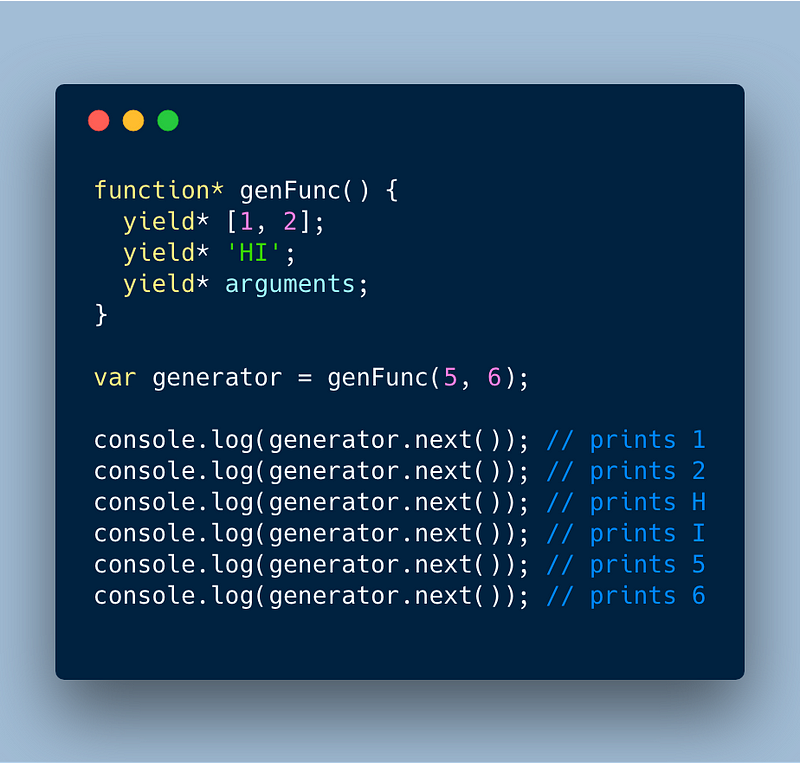 Yield over built-in iterables
Yield over built-in iterables
Here in the code the yield iterates over every possible iterable object that is passed as its expression. I guess the code itself is self-explanatory.
Best Practices
On top of all this, every iterator/generator can be iterated over a for…of loop. Similar to our next() method which is called explicitly, for…of loop internally moves on to the next iteration based on the yield keyword. And it iterates only till the last yield and doesn’t process the return statements like the next() method.
You can verify the same in the code below.
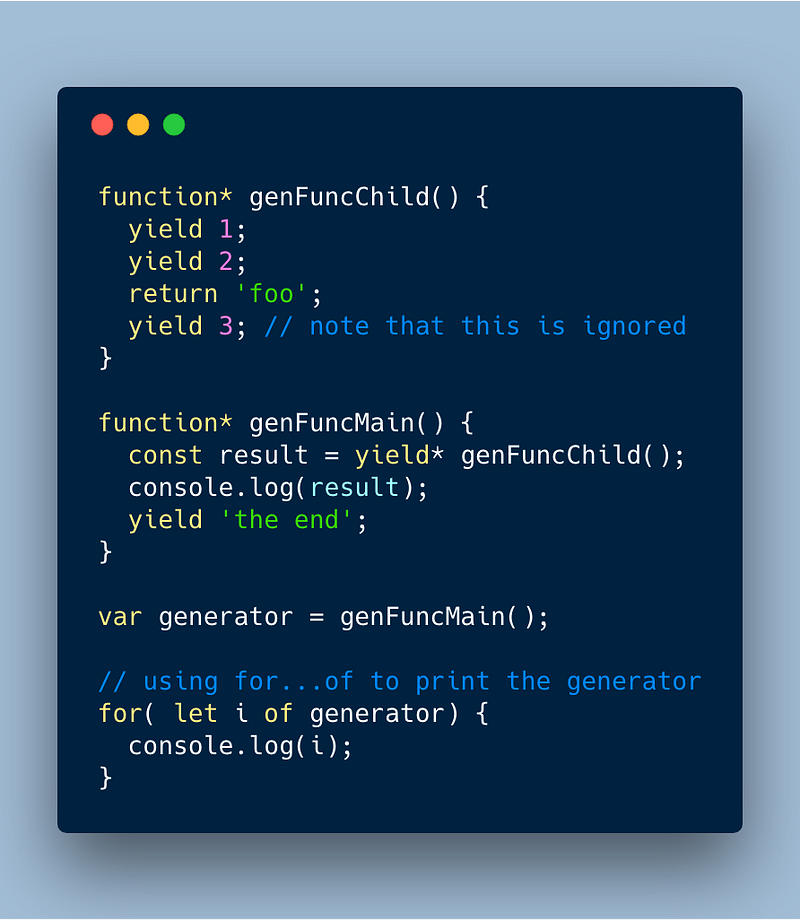 Yield with for…of
Yield with for…of
The final return value is not printed, because for…of loop iterates only till the last yield. So, it comes under best practice to avoid return statements inside a generator function as it would affect the reusability of the function when iterated over a for…of.
Conclusion
I hope this covers the basic use-cases of generator functions and I sincerely hope that it gave a better understanding of how generators work in JavaScript ES6 and above.